
Euphorbia is a very large and diverse genus of flowering plants, commonly called spurge, in the family Euphorbiaceae. "Euphorbia" is sometimes used in ordinary English to collectively refer to all members of Euphorbiaceae, not just to members of the genus.
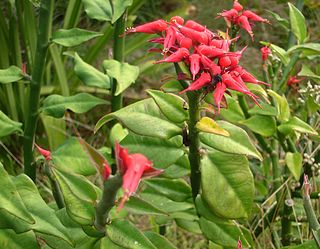
Euphorbia tithymaloides is a perennial succulent spurge. An erect shrub, the plant is also known by the scientific name Pedilanthus tithymaloides. However, the genus Pedilanthus has been subsumed into the genus Euphorbia, and is more correctly known by its new name.

In botany, succulent plants, also known as succulents, are plants with parts that are thickened, fleshy, and engorged, usually to retain water in arid climates or soil conditions. The word succulent comes from the Latin word sucus, meaning "juice" or "sap".
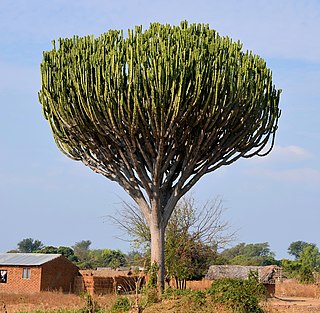
Euphorbia ingens is a species of flowering plant in the family Euphorbiaceae. It is native to dry areas of southern Africa. It is popularly known as the candelabra tree or naboom. Its milky latex can be extremely poisonous and is a dangerous irritant.

Euphorbia balsamifera is a flowering plant in the spurge family Euphorbiaceae. It is distributed in the Canary Islands and the western Sahara. It is the vegetable symbol of the island of Lanzarote. Euphorbia adenensis has been treated as a subspecies of this species.

The Albany thickets is an ecoregion of dense woodland in southern South Africa, which is concentrated around the Albany region of the Eastern Cape.

Euphorbia caput-medusae is a plant of the genus Euphorbia that occurs in and around Cape Town, South Africa.

Euphorbia mammillaris is a plant species endemic to Cape Province of South Africa. Euphorbia mammillaris, also known as African or Indian corn-cob, is a fast-growing shrublet, with thick stems that are chalky green, erect and ribbed.

Euphorbia trigona, the African milk tree, cathedral cactus, or Abyssinian euphorbia, is a species of flowering plant that originates from Central Africa. Somewhat common in cultivation as a houseplant or as a hedge, the species is one of the euphorbias with succulent stems and branches as an adaptation to arid climates.
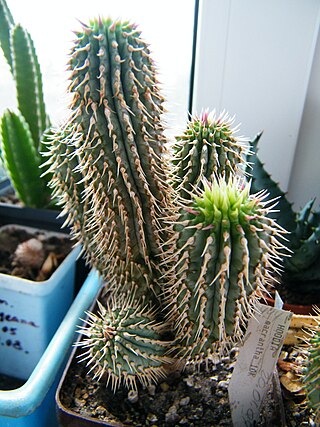
Stem succulents are fleshy succulent columnar shaped plants which conduct photosynthesis mainly through their stems rather than their leaves. These plants are defined by their succulent stems and have evolved to have similar forms by convergent evolution to occupy similar niches.

Euphorbia flanaganii, commonly known as Transkei medusa's head, is a succulent plant that belongs to the family Euphorbiaceae. It is endemic to South Africa. Due to the breadth of the Euphorbiaceae, little research specific to E. flanaganii has been conducted.
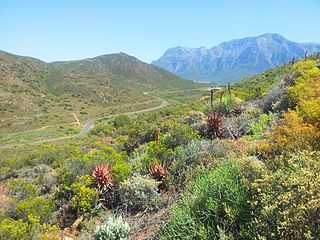
Robertson Karoo is a semi-arid vegetation type, restricted to sections of the Breede River Valley, Western Cape Province, South Africa. It is a subtype of Succulent Karoo and is characterised by the dominance of succulent plant species, and by several endemic plants and animals.

Euphorbia rowlandii, the Levuvhu euphorbia, is a succulent member of the spurge family native to the Soutpansberg region in South Africa, and southeastern Zimbabwe. It is a medium-sized, monoecious shrub with multiple spiny blue-green photosynthetic stems. The species is superficially similar to E. waterbergensis, and is named after the Levubu River.

Viscum minimum is a species of mistletoe in the family Santalaceae. It is a parasitic plant native to South Africa.

Duvalia elegans is a small succulent plant species, in the family Apocynaceae. It is the type species of the genus Duvalia, and it is endemic to the Western Cape Province, South Africa.

Euphorbia tuberosa, commonly known as '"milkball/melkbol"' or '"wilderamenas"', is a variable geophytic plant of the family Euphorbiaceae, indigenous to the western parts of South Africa.
Euphorbia tenax is a species of Euphorbia endemic to South Africa, where it occurs in the Northern Cape and Western Cape provinces, around Kotzesrus and southwards as far as Nieuwoudtville and Cape Town. Its preferred habitat is sand Fynbos and Succulent Karoo on shale-derived slopes.
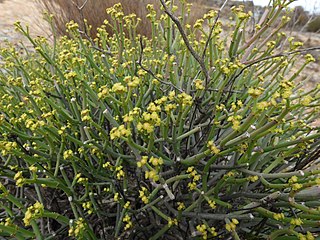
Euphorbia rhombifolia is a species of flowering plant in the Euphorbiaceae family. It is native to Namibia and South Africa, where it is widespread in clay-rich soils, extending as far east as Kwazulu-Natal.

Euphorbia mauritanica, commonly known as yellow milk bush or golden spurge, is a species of plant in the family Euphorbiaceae native to Africa.

Euphorbia meloformis, called the melon spurge, is a species of flowering plant in the genus Euphorbia, native to the Cape Provinces of South Africa. A succulent, it has gained the Royal Horticultural Society's Award of Garden Merit.




















